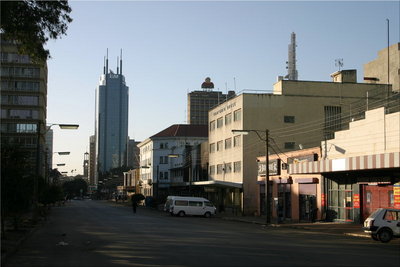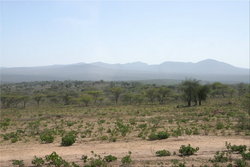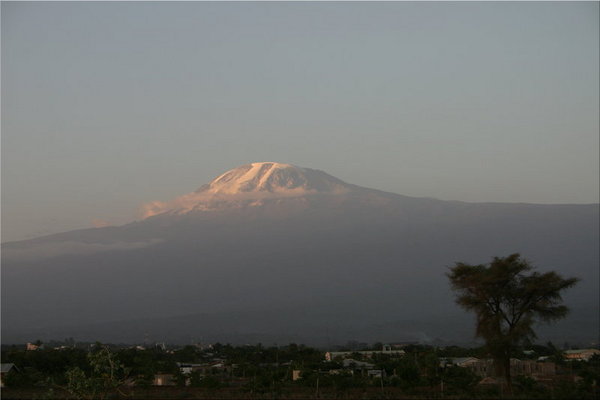

|
|
Nairobi, morning street scene
|
The Davanu shuttle bus is a 37 seater Mitsubishi, apparently direct from Japan (where they also drive on the left side of the road). At least, there are Japanese characters all over the switch gear. The speedometer permanently reads 28 km/h, the fuel gauge permanently reads "empty" and there is no evidence of actual cold air from the air conditioning. The tires are the same style of locally made all-terrain tires one sees on land rovers here. I'm not even sure they are radial tires. Otherwise, the bus is in good condition.
Driving through the suburbs, I remark on the slummy neighbourhoods and on the walls that surround anything of value. Sometimes the walls have glass shards or barbed wire on top. Many buildings look lived in, but to my view only half constructed, with unfinished brick walls, empty window openings and such. Streets are unpaved, and vehicles belch clouds of smoke.
We stop at the airport and then head into the countryside, after a couple of police checkpoints which always consist of some tire bursting spikes you need to steer around, one guy with a machine gun, and a couple of others who stop whatever vehicles they feel like. The cops wear military style berets and look scary, but the one time our bus is stopped, the driver has a cheerful 30 second conversation with the cop in Kiswahili, and then we are waved on.

|
|
Typical southern Kenya countryside
|
Whenever there is a town, the road has big speed bumps. The cops don't need to go chasing speeders here. The towns are dusty, unpaved, with primitive shacks for buildings. To me they look depressingly poor.
Whatever else this area doesn't have, it does have cell phone service. We see the towers at irregular intervals.
Passing works differently here. It is done cooperatively. First the vehicle to be passed signals left (i.e. to the side of the road) to indicate that it is OK to pass, that the road is clear. Then our bus passes it leisurely, in much too high a gear (we will notice that driving at near engine stall speeds is almost universal here. 25km/h? Better shift into 4th). If someone is coming the other way, they slow down to make room. At any rate, nothing happens too fast, 80km/h is about the order of the day on the bumpy highway. There isn't much traffic at any rate, and what there is is mostly all-terrain vehicles and minibuses. We play tag with another big bus. Ours is full of white tourists. The other one is full of locals and stops frequently to take on or drop off passengers.
We stop at a "curio shop" where there are washrooms. The curio shop is huge, with thousands of pieces of local crafts. Some of the carvings are very nice, but in a 10-minute stop I would never buy anything. No prices are marked. I ask and I am told "it is between the buyer and the seller".
At the Tanzanian border, first we need to fill out exit declaration forms on the Kenyan side. Many people mill around the bus, trying to sell us things. I see some picturesque locals and aim my camera, and instantly a woman materializes by the bus window and asks for payment. Though the price drops from two dollars to 50 cents before I stop paying attention, I don't bother with the picture.
A little further on is the Tanzanian border compound. It has an iron fence all around, and openings just wide enough for one vehicle on either side. The bus squeezes through and parks. Other buses are already here, and border agents are on the roofs, looking at the bags. We file into the customs shack. I notice that they have Dell computers with flatscreen monitors in there, somewhat incongruous with the dust and the corrugated metal roofs outside. My passport is barely glanced at before my Tanzanian visa is multiply stamped. When I get back to the bus, the man who has been riding shotgun all along is on the roof, watching the bags. As far as I can tell they have not been disturbed. I'm beginning to understand why the bus has a staff of two: Either the driver or the other guy is always with it and guards it.
The landscape gets noticeably lusher as we gain altitude near Mount Meru. Ultimately the road reaches about 6000 feet, and this is a blessed altitude in these parts. The fields are lush and green. The simple villages, with no electricity or glass windows, and walls of locally made bricks, and thatched roofs, look tidy and pretty. The people are colourfully dressed and wave cheerfully. All this without motor vehicles or television or coca cola. I love it.
Then we descend into Arusha, which is leafy with banana trees, and stop at the Mount Meru Hotel. Two very serious looking guards man the gate. "Lock your doors", a sign reminds anyone driving out of the compound.
I seize the opportunity to climb onto the roof of the bus, to help sort out the bags since most of the passengers are getting off here. We continue on the highway east to Moshi. This highway resembles a large 2-digit Ontario highway back home, and it goes through fairly modern farms and settlements. Even an occasional modern glass office building does not look out of place here. A heap of clouds to the left completely hides Mt. Kilimanjaro. We will learn that this is normal for this time of day.
There is more traffic here, but still it is almost all utility vehicles. All-terrain vehicles from Suzuki Samurai to "Land Rover Defender" in size, minibuses, big buses, trucks. Perhaps one vehicle in 10 is an ordinary car. Perhaps 8 vehicles out of 10 are Toyotas; the rest are other Japanese brands, with the occasional Peugeot mixed in. And of course land rovers of all vintages.
We stop at Davanu headquarters and pick up a third staff member, who appears to outrank the driver and the copilot. Then the bus drops the passengers off at their hotels.
We are staying at the Springlands Hotel, which seems to cater exclusively to customers of Zara Tours, which has an office here. It is very fancy, and completely walled off from the outside. We are introduced to Chombo, our guide for the Kilimanjaro climb. The answers to many of our questions are vague - how much can we give to the porters to carry? Route details? Acclimatization days? Sleeping mats? It will be "organized" he says. No problem. Be ready at 8AM tomorrow.

|
|
First look at Kilimanjaro, in the evening from Moshi
|
In the evening, I wander out the front gate, and... oh wow. Kilimanjaro has shed its clouds and is glowing in the sunset. I come right back with the camera. After I've got that picture, I take some of the compound from outside, but am quickly chased back inside by a guard, who explains that it is not safe to be out after dark. I make some sarcastic comments about getting back into the chicken house, but do so. In general, I feel a little bit rubbed the wrong way by this walled fortress with 100% white guests amidst a poor black neighbourhood.
The hotel has internet access via a wire dish antenna on the roof (the ISP is kilinet). It costs $1 for 15 minutes and so we catch up on our email.
Our beds have mosquito nets. We all took our first "Malarone" anti-malaria tablet at breakfast in Nairobi yesterday, and will continue to take these until 5 days after we return to Ottawa.